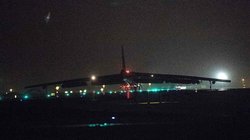 The United States Air Force temporarily shifts its command center from Qatar to South Carolina amid President Donald Trump’s escalation of tensions with Iran, according to a report.
The United States Air Force temporarily shifts its command center from Qatar to South Carolina amid President Donald Trump’s escalation of tensions with Iran, according to a report. RNA - The unannounced operation marked the first time in 13 years that the US command and control was moved out of the region, The Washington Post reported.
As a result, the Combined Air and Space Operations Center at al-Udeid Air Base in Qatar was left empty on Saturday and Shaw Air Force Base in South Carolina was put in charge of controlling US operations from 7,000 miles away.
“The functions that the CAOC provides for air power are so critical and so essential that we can't afford to have a single point of failure,” Major General B. Chance Saltzman stated, using an acronym for the center.
Colonel Frederick Coleman, the commander of the 609th Air and Space Operations Center, also claimed that, “Iran has indicated multiple times through multiple sources their intent to attack US forces.”
“Frankly, as the war against ISIS (also known as Daesh or ISIL) winds down and as we continue to work through a potential peace process in Afghanistan, the region is calming down and potentially more stable than it has been in decades, except for Iran,” he alleged.
Tehran has for several times underlined that given the increasing power of Iran, the American forces should leave the region.
Iranian President Hassad Rouhani has recently stated that foreign military presence in the Middle East has put energy security and peace in serious danger, adding that trans-regional forces should leave the region if they are honestly concerned about security.
Tensions mounted between Tehran and Washington last May, when President Donald Trump pulled the United States out of the nuclaer deal, and re-imposed harsh sanctions against the Islamic Republic in defiance of global criticism. The American leader and his hawkish advisers former National Security Advisor John Bolton and Secretary of State Mike Pompeo have since been stepping up pressure against Iranians.
The crisis saw a sharp rise on the first anniversary of Washington’s exit from the deal as the US moved to ratchet up pressure on Iran by tightening its oil sanctions and sending military reinforcements, including an aircraft carrier strike group, a squadron of B-52 bombers, and a battery of Patriot missiles, to the Persian Gulf region.
Tensions between Washington and Tehran hit a new high in June after the US sent a number of military aircarft to the Iranian skies under a tense climate of escalating threats, forcing the Islamic Revolution Guard Corps (IRGC) Aerospace Force to shoot down one of the intruding American aircraft.
Following the recent attacks by Yemeni forces on Saudi-owned major oil facilities, the United States announced it will send troops to Saudi Arabia and the United Arab Emirates to bolster Riyadh's air defenses.
Iran has time and again stressed that it will not be the initiator of any war, but reserves the right to self defense and will give a crushing response to any act of aggression by the United States.
847/940